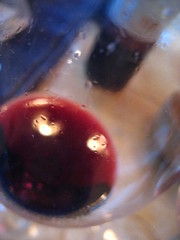 [Ben sez]: Now that our Asian adventure is quickly fading into the past we're not really eating out for three meals a day (plus four snacks and two desserts), and being the currently unemployed college graduates we are, we don't make it out to eat multiple times a week to find something to write about. As an alternative we've decided to treat you to some of our favorite home cooking (as with the smoked pork two weeks ago).
[Ben sez]: Now that our Asian adventure is quickly fading into the past we're not really eating out for three meals a day (plus four snacks and two desserts), and being the currently unemployed college graduates we are, we don't make it out to eat multiple times a week to find something to write about. As an alternative we've decided to treat you to some of our favorite home cooking (as with the smoked pork two weeks ago).This week is Ben et Nate's favorite meal: Steak and Mashed Sweet Potatoes (or Yams if that's your preferred nomenclature).
The first step in making this awesome meal is to find yourself a reputable source for good meat. I happen to luckily live mere blocks from a
 butcher called "Ready Meats", or as I like to call it, "The happiest place on Earth." I might have spent too much time and money there since they all know my name and recent events of my life, but the key is to find a butcher you can trust as a source for high quality products and maintain a healthy relationship with them.
butcher called "Ready Meats", or as I like to call it, "The happiest place on Earth." I might have spent too much time and money there since they all know my name and recent events of my life, but the key is to find a butcher you can trust as a source for high quality products and maintain a healthy relationship with them.Once you've acquired your steak(s) there are only a couple steps to perfection:
1) heat up a cast iron pan in a 500° oven
2) heavily salt and pepper both sides and rub with oil
3) cook 30-45 seconds on each side over high heat on your stove
4) finish with two minutes on each side in the oven
5) let it rest for five minutes.
This is the Alton Brown/Good Eats method which I use for every steak in the 1/2" to 1" thick range - sirloin, ribeye, strip. With those instructions you should be able to turn out steak house quality steaks for a fraction of the price.
 Of course a "meat and potatoes" meal needs some kind of potato, once again I turned to Alton Brown (one of my food heroes) for inspiration. In the yam episode of Good Eats ("Potato, My Sweet") he prepares a wonderful sweet potato mash spiced up with some chipotle peppers in adobo sauce. It dawned on me after I'd thrown away my third can of half-used chipotles in adobo sauce that there had to be a better answer - Chili Garlic Sauce! Steam some cubed sweet potatoes, mash them, add salt, pepper, butter and some Chili Garlic Sauce and you're in business. Extremely delicious business.
Of course a "meat and potatoes" meal needs some kind of potato, once again I turned to Alton Brown (one of my food heroes) for inspiration. In the yam episode of Good Eats ("Potato, My Sweet") he prepares a wonderful sweet potato mash spiced up with some chipotle peppers in adobo sauce. It dawned on me after I'd thrown away my third can of half-used chipotles in adobo sauce that there had to be a better answer - Chili Garlic Sauce! Steam some cubed sweet potatoes, mash them, add salt, pepper, butter and some Chili Garlic Sauce and you're in business. Extremely delicious business.I don't steal all my tricks from Alton Brown, I swear.. just most of them.
 [Nate sez]: Of course there needs to be a solid beverage to accompany this perfect meal. Beer immediately comes to mind because of the quintessential American nature of the meat and potatoes paradigm. However, our ill-mannered, cigarette smoking, coffee swilling, art snobbing friends in France have a much better match for steak et yam: Bordeaux. It can be strong, smoky, and tannic, or silky, smooth and succulent. With meat and taters, you couldn't ask for a better match either way.
[Nate sez]: Of course there needs to be a solid beverage to accompany this perfect meal. Beer immediately comes to mind because of the quintessential American nature of the meat and potatoes paradigm. However, our ill-mannered, cigarette smoking, coffee swilling, art snobbing friends in France have a much better match for steak et yam: Bordeaux. It can be strong, smoky, and tannic, or silky, smooth and succulent. With meat and taters, you couldn't ask for a better match either way.What the hell is Bordeaux anyways? Why do most all French wines have silly names like Sancerre, Pouilly-Fumé, Chateauneuf-du-Pape (which means New Countryhouse/Castle/Residence of the Pope)? A brief answer:
French wine is classified not by varietal (like Cabernet, Merlot, Syrah), but by region (Like Napa, CA or Williamette, OR). Each region has specific wines that thrive in that environment; Napa grows mostly Cabernet, Chardonnay, and Merlot, and Williamette grows mostly Pinot Noir and Pinot Gris.
 And even when we buy a Napa Cabernet, other wines (Cabernet Franc, Petit Verdot, etc) are blended in to balance out the flavor of the main variety - so in essence, almost all wines are blends.
And even when we buy a Napa Cabernet, other wines (Cabernet Franc, Petit Verdot, etc) are blended in to balance out the flavor of the main variety - so in essence, almost all wines are blends.Bordeaux is a region, like Napa. The main grapes grown are Cabernet Sauvignon, Merlot, Chardonnay, Sauvignon Blanc, and Semillon. When you pick up a bottle of Bordeaux at your vinomart, its color will give you the first level of insight into what the bottle contains - red is Cab or Merlot dominant, and white is Chardonnay or Sauvignon Blanc dominant. Most likely. With French wine, the varietal note is not necessarily as important as the overall quality of the wine. To put it lightly, it takes a retarded amount of "education" (read drinking) to remember which of subregions correspond to which dominant flavors (like St. Emillion is Merlot dominant, whereas Margaux is Cab dominant, but not as Cab dominant as Pauillac...).
The point here people: find yourself a wine merchant who you trust and gives you good, low price recommendations. I know I mentioned Solo Vino last week, but I'll mention it again. Ben and I learned gobs about wine from talking to the employees (who all have Sommelier licenses BTW), and they consistently sell us low price bottles that shock and amaze. We're talking $11-16 for bomb-ass Bordeaux k?
 Bordeaux is beautiful, and though some of the most expensive bottles of wine in existence come from there, here are a few bottles that run the range of what is affordable, can be drank now, and can be cellared down for years to come:
Bordeaux is beautiful, and though some of the most expensive bottles of wine in existence come from there, here are a few bottles that run the range of what is affordable, can be drank now, and can be cellared down for years to come:Ch. (that means Chateau) Cluzan Bordeaux, 2003 - Smells like cherries, rasberries, and other misc. red fruit, and tastes the same. The fruit is balanced out by a nice smoky oak, medium body and overall acidity. This is a drinker for right now - it feels soft, and easy to drink by itself, but pairs beautifully with just about anything that can take red wine.
Ch. Haut Lucas Côtes de Castillon, 2003 - at $16, it's a freaking steal - and I rarely want to spend more than $12. This wine is soft but structured, med-light bodied, not too dry, black-fruity, and just simply impossible to argue with. It's also 90% Merlot and 10% Cabernet Franc. I know it sounds wussy (I'm not drinking fucking Merlot!), but Haut Lucas has a very mature and artful presence - this is not like crappy, overripe, 18% alcohol, hangover-inducing CA Merlot we've all burnt out on. It's definitely Merlot based, and there's nothing wrong with that. Did you hear me? - (french) MERLOT ROCKS MY WORLD!!!
 Ch. Les Eyraux, 2005 - This Cabernet forward wine will need a few years to iron out it's bitterness and astringency (from tannins), but is fantastic with a fatty piece of meat right now. The aroma is definitively Cab - a bit vegetal and a bit dark fruit, countered with a great campfire smell coming up from your glass. Light bodied and neither sweet nor dry, the main flavor is of simple red fruit. It's not the kind of thing you would sit around and drink right now - it's too rough. Make sure you serve it with food - and buy a few extras to put in your cellar to drink in 2010.
Ch. Les Eyraux, 2005 - This Cabernet forward wine will need a few years to iron out it's bitterness and astringency (from tannins), but is fantastic with a fatty piece of meat right now. The aroma is definitively Cab - a bit vegetal and a bit dark fruit, countered with a great campfire smell coming up from your glass. Light bodied and neither sweet nor dry, the main flavor is of simple red fruit. It's not the kind of thing you would sit around and drink right now - it's too rough. Make sure you serve it with food - and buy a few extras to put in your cellar to drink in 2010.














